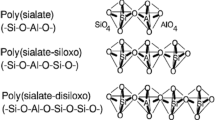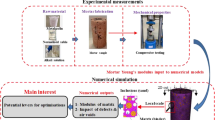Abstract
On account of growing environmental and economic concerns, decarbonization of the concrete industry has become a priority with the development of environmentally friendly building materials to attract both research community and industry. A class of advanced environmentally friendly building materials is geopolymer mortars. Their production incorporates mostly industrial by-products in lieu of cement which has a double benefit in terms of sustainability: recycling industrial wastes instead of harmful disposal and reducing carbon footprint by eliminating cement. Although geopolymer mortars have similar or enhanced performance compared to conventional mortars, their development and optimization techniques are vastly different. This study explores two optimization techniques widely used in the development of high-strength and high-performance mortars, namely the use of chemical admixtures and particle packing theory. More specifically ten different admixtures and six different sand contents based on packing density were investigated along with their effect on fresh and hardened state properties such as workability, setting time, and compressive strength, respectively. Higher sand contents improved the compressive strength, while slightly compromising the workability. Finally, it is observed that chemical admixtures developed for OPC concretes are not ideal for geopolymer concretes and interventions such as reducing the temperature of the mixing components could be an effective method to manipulate fresh state properties without compromising the mechanical strength.
Access this chapter
Tax calculation will be finalised at checkout
Purchases are for personal use only
Similar content being viewed by others
References
Davidovits, J.: Solid-Phase Synthesis of a Mineral Block polymer by Low Temperature Polycondensation of Alumino-Silicate Polymers. In: IUPAC International Symposium on Macromolecules, Stockholm, Sweden (1976)
Ralli, Z.G., Pantazopoulou, S.J.: State of the art on geopolymer concrete. Int. J. Struct. Integr. 12(4), 511–533 (2021)
Prusty, J.K., Pradhan, B.: Investigation on effect of precursor materials and sand-to-binder ratio on strength development, acid resistance and microstructure evolution of geopolymer mortar. Constr. Build. Mater. 346, 128501 (2022)
Wang, Y., Wang, Y., Zhang, M.: Effect of sand content on engineering properties of fly ash-slag based strain hardening geopolymer composites. J. Build. Eng. 34, 101951 (2021)
Andrade, I.K.R., Mendes, B.C., Pedroti, L.G., Vieira, C.M.F., de Carvalho, J.M.F.: Influence of the sand content on the physical and mechanical properties of metakaolin-based geopolymer mortars. In: Characterization of Minerals, Metals, and Materials 2022, pp. 381–389 (2022)
Andreasen, A.H.M., Andersen, J.: Über die Beziehung zwischen Kornabstufung und Zwischenraum in Production aus losen Körnern (mit einigen Experimenten). Colloid Polym. Sci. 50(30), 217–228 (1930)
Li, P.P., Yu, Q.L., Brouwers, H.J.H.: Effect of coarse basalt aggregates on the properties of Ultra-high Performance Concrete (UHPC). Constr. Build. Mater. 170, 649–659 (2018)
Provis, J.L., Duxson, P., van Deventer, J.S.J.: The role of particle technology in developing sustainable construction materials. Adv. Powder Technol. 21(1), 2–7 (2010)
Borges, P.H.R., Fonseca, L.F., Nunes, V.A., Panzera, T.H., Martuscelli, C.C.: Andreasen particle packing method on the development of geopolymer concrete for civil engineering. J. Mater. Civ. Eng. 26(4), 692–697 (2014)
Nematollahi, B., Sanjayan, J.: Effect of different superplasticizers and activator combinations on workability and strength of fly ash based geopolymer. Mater. Des. 57, 667–672 (2014)
Davidovits, J.: Geopolymer Chemistry & Applications (5th ed.). Geopolymer Institute (2020)
Rattanasak, U., Pankhet, K., Chindaprasirt, P.: Effect of chemical admixtures on properties of high-calcium fly ash geopolymer. Int. J. Miner. Metall. Mater. 18(3), 364–369 (2011). https://doi.org/10.1007/s12613-011-0448-3
Ranjbar, N., Kuenzel, C., Spangenberg, J., Mehrali, M.: Hardening evolution of geopolymers from setting to equilibrium: A review. Cement Concr. Compos. 114, 103729 (2020)
Ralli, Z.G., Pantazopoulou, S.J., Papangelakis, V.G.: Microstructural Characterization of High-Performance Fiber Reinforced Geopolymer Concrete. In: Acta Polytechnica CTU Proceedings, p. 33 (2022)
Funk, J.E., Dinger, D.R.: Predictive Process Control of Crowded Particulate Suspensions. Springer US, Boston, MA (1994). https://doi.org/10.1007/978-1-4615-3118-0
Yu, R., Spiesz, P., Brouwers, H.J.H.: Mix design and properties assessment of Ultra-High Performance Fibre Reinforced Concrete (UHPFRC). Cem. Concr. Res. 56, 29–39 (2014)
ASTM C1856.: Standard Practice for Fabricating and Testing Specimens of Ultra-High Performance Concrete. In: Annual Book of ASTM Standards, 4(4). (2017)
ASTM C191.: Standard Test Methods for Time of Setting of Hydraulic Cement by Vicat Needle. In Annual Book of ASTM Standards 4(1) (2021)
ASTM C39.: Standard Test Method for Compressive Strength of Cylindrical Concrete Specimens. In Annual Book of ASTM Standards 4(2). (2021)
Vance, K., Kumar, A., Sant, G., Neithalath, N.: The rheological properties of ternary binders containing Portland cement, limestone, and metakaolin or fly ash. Cem. Concr. Res. 52, 196–207 (2013)
Author information
Authors and Affiliations
Corresponding author
Editor information
Editors and Affiliations
Rights and permissions
Copyright information
© 2023 The Author(s), under exclusive license to Springer Nature Switzerland AG
About this paper
Cite this paper
Ralli, Z., Pantazopoulou, S.J. (2023). Effect of Aggregate Skeleton and Admixtures on Fresh and Hardened Properties of High-Strength Geopolymer Mortars. In: Jędrzejewska, A., Kanavaris, F., Azenha, M., Benboudjema, F., Schlicke, D. (eds) International RILEM Conference on Synergising Expertise towards Sustainability and Robustness of Cement-based Materials and Concrete Structures. SynerCrete 2023. RILEM Bookseries, vol 44. Springer, Cham. https://doi.org/10.1007/978-3-031-33187-9_39
Download citation
DOI: https://doi.org/10.1007/978-3-031-33187-9_39
Published:
Publisher Name: Springer, Cham
Print ISBN: 978-3-031-33186-2
Online ISBN: 978-3-031-33187-9
eBook Packages: EngineeringEngineering (R0)




